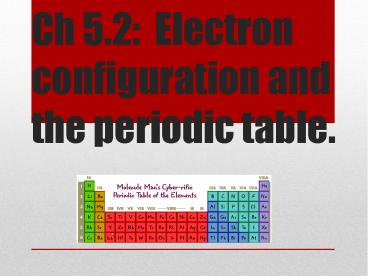Ch 5.2: Electron configuration and the periodic table. - PowerPoint PPT Presentation
Title:
Ch 5.2: Electron configuration and the periodic table.
Description:
Ch 5.2: Electron configuration and the periodic table. In general terms, the electron configuration of an atom s highest occupied energy level determines the atom ... – PowerPoint PPT presentation
Number of Views:169
Avg rating:3.0/5.0
Title: Ch 5.2: Electron configuration and the periodic table.
1
Ch 5.2 Electron configuration and the periodic
table.
2
- In general terms, the electron configuration of
an atoms highest occupied energy level
determines the atoms chemical properties.
3
Periods and Groups
- Elements are arranged vertically in groups that
share similar chemical properties.
4
Periods and Groups
- Elements are arranged horizontally in periods
- the length of each period is determined by the
number of electrons that can occupy the sublevels
being filled in that period.
5
Sublevel Blocks
- Based on the electron configuration of the
elements, the periodic table can be subdivided
into four sublevels, or blocks.
6
Alkali Metals Group 1 ( ns1)
- Most reactive, soft, silvery metals.
- Stored under kerosene/oil.
- Are not found free in nature, but as compounds -
too reactive to exist alone. - Combine readily with non metals.
- Combine readily with water
- 2 H2O 2 X ? H2 2 XOH
- Melting point decreases as you move down the
group.
Group configuration
7
Alkaline Earth metals Group 2 (ns2)
- Barium in oil.
- Similar to group 1, but are harder, denser,
stronger, and have higher melting points. - Less reactive than the alkali metals, but still
too reactive to be found free in nature.
8
Special Cases H and He
- By electron configuration H is in Group 1, but it
does not have the characteristics of an alkali
metal. - By electron configuration He should be in Group
2, but it does not have the chemical
characteristics of the group and acts as a noble
gas, so it is put in Group 18.
9
Example 1
- Without looking at the periodic table, give the
group, period, and block in which the element
with the electron configuration Xe6s2 is
located. - Group 2 (ns2)
- Period 6 (6s2)
- Block s (6s2)
10
Example 2
- Without looking at the periodic table, write the
electron configuration for the Group 1 element in
the third period. - 1s22s22p63s1
11
Example 2
- Which element is likely to be more active
- Xe6s2 or 1s22s22p63s1 ?
- 1s22s22p63s1 because it is in Group 1 (alkali
metals)
12
Example 3
- Without looking at the periodic table, give the
group, period, and block in which the element
with the electron configuration Kr5s1 is
located. - Group 1 (ns1)
- Period 5 (5s1)
- Block s (5s1)
13
Example 4
- Without looking at the periodic table, write both
the group configuration and the complete electron
configuration for the Group2 element in the 4th
period. - Group ns2
- 1s22s22p63s23p64s2
14
Transition metals (d block) Groups 3-12
- Sum of d and s electrons give group number of the
element. Ex. Cr Ar 4s13d5 is in group 6. - Metallic properties (shiny, conduct heat and
electricity, ductile, malleable) - ns2(n-1)dx
15
Transition Metals
- are less reactive than Groups 1 and 2
- Some are so unreactive that they do not easily
form compounds and can exist in nature as free
elements (also called native elements).
Native gold
16
Example 4
- An element has the electron configuration
Kr5s24d10 Without looking at the periodic
table, identify the period, block, and group in
which this element is located. - Period 5 (5s2)
- Block d (5s24d10)
- Group 12 (210)
17
P block elements Group 13-18
- The p-block elements together with the s-block
elements are called the main group elements. - The properties of the elements in the p block
vary greatly (mixture of metals, metalloids,
non-metals, and the noble gases). - (ns2np1 through ns2np6)
- Group number ns electrons np electrons 10
18
P block elements Group 13-18
- Metalloids Brittle solids, semiconductors,
exhibit properties of both nonmetals and metals. - P-block metals less dense and hard than d-block
metals, but greater than Groups 1 and 2. When
pure, are stable in the presence of air. - Noble gasesunreactive. Why????
19
Group 17 The Halogens
- Halogens most reactive nonmetals
- React vigorously with metals, forming salts.
- F2 (green gas), Cl2 (yellow gas), Br2 (red
liquid), I2 (purple solid). - (ns2np5)
20
Group 18 - Noble Gases
- Stable elements, do not normally undergo chemical
reactions. - The stability is a result of electrons filling
the highest energy level. - Helium is 1s2, all the other noble gases are said
to have stable octets because the configuration
is ns2 np6 (8 electrons in outer energy level
octet). - (ns2np6)
21
Lanthanides (Rare Earths)
- Shiny, reactive metals.
- Similar in reactivity to the Group 2 alkaline
earth metals. - Electrons fill up f orbitals.
- Atomic 58-71
22
Actinides
- All radioactive metals.
- First 4 naturally occurring.
- The remainder are called the transuranic elements
(beyond uranium), and are synthesized - Atomic 90-103
23
Example 5
- An element has the electron configuration
Ne3s23p5 Without looking at the periodic
table, identify the block, and group in which
this element is located. - Block p (3s23p5)
- Group 17 (2510)
24
Example 6
- An element has the electron configuration
Ne3s23p5 What element is this? Is this a
metal, nonmetal, or metalloid? - Chlorine
- Group 17 halogen (non-metal), which means it is
very reactive.
25
Example 6
- An element has the electron configuration
Xe6s24f6 What element is this? Is this a
metal, nonmetal, or metalloid? - This is an f-block element in the lanthanides
(4f). Samarium, Sm. - Lanthanides are reactive metals.
26
Assignment Due tomorrow
- 5.2 Worksheet
Yee-hah!!!































